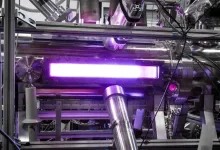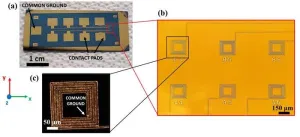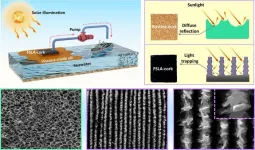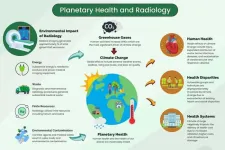(Press-News.org) We use computers to help us make (hopefully) unbiased decisions. The problem is that machine-learning algorithms do not always make fair classifications, if human bias is embedded in the data used to train them — which is often the case in practice. To ease this "garbage in, garbage out" situation, a research team presented a flexible framework for mitigating bias in machine classification. Their research was published Apr. 8 in Intelligent Computing, a Science Partner Journal.
Existing attempts to mitigate classification bias, according to the team, are often held back by their reliance on specific metrics of fairness and predetermined bias terms. The team's framework avoids these two types of reliance; their bias mitigation can be evaluated under different fairness metrics, and they infer specific bias terms from the data.
The team evaluated the framework on seven datasets across 21 machine classifiers. Across the experiments, bias in classification outcomes is substantially reduced with classification accuracy largely preserved — working desirably under the fairness-utility trade-off.
The framework shares the setup of the adversarial debiasing method, considering a propose-review scenario between Alice, e.g., the enterprise, and Bob, e.g., the regulator. Alice sends a proposal to Bob for using his data to develop a target classifier, say, a college matching system. Bob reviews the proposal and aims to make sure that Alice’s classification does not demonstrate substantial bias along a sensitive dimension that he aims to protect, say, students’ middle-school transfer experience. The goal is to build a classifier that has minimal discrimination along the protected dimension(s) with only a small performance sacrifice in the target classification.
Bias mitigation is achieved by identifying data attributes that are prone to introducing bias and then applying effective data transforms on records under these attributes. This involves assessing the contribution of attributes to data separation, computing the distances between attributes, and establishing with these distances a bias-attribute mapping in the constructed bias hyperspace. With this mapping, bias terms are inferred, bias-prone attributes are recognized, and their bias concentrations are measured.
However, the workflow may encounter difficulties when applied to large datasets, due to limitations in scalability, among other factors.
In future research, the team is interested in extending the framework to directly strike a balance between classification fairness and accuracy, considering the potential conflict between the public and private sectors. From a broader standpoint, incorporating behavioral features into classification bias mitigation and analyzing practical setups in the application of such frameworks is an important direction.
END
New mitigation framework reduces bias in classification outcomes
Independent of fairness metrics and with no predetermined bias terms
2024-04-23
ELSE PRESS RELEASES FROM THIS DATE:
Zap Energy achieves 37-million-degree temperatures in a compact device
2024-04-23
In the nine decades since humans first produced fusion reactions, only a few fusion technologies have demonstrated the ability to make a thermal fusion plasma with electron temperatures hotter than 10 million degrees Celsius, roughly the temperature of the core of the sun. Zap Energy’s unique approach, known as a sheared-flow-stabilized Z pinch, has now joined those rarefied ranks, far exceeding this plasma temperature milestone in a device that is a fraction of the scale of other fusion systems.
A new research paper, published this month in Physical ...
Magnetic microcoils unlock targeted single-neuron therapies for neurodegenerative disorders
2024-04-23
WASHINGTON, April 23, 2024 — Neural stimulation is a medical technique used to treat many illnesses affecting the nervous system. It involves applying energy to neurons to encourage them to grow and make connections with their neighbors. Treatments for epilepsy can often include neural stimulation, and similar treatments exist for Parkinson’s disease, chronic pain, and some psychiatric illnesses.
In the Journal of Vacuum Science & Technology A, by AIP Publishing, researchers from the University of Minnesota deployed an array of microscopic coils — microcoils — to create ...
Laser-treated cork absorbs oil for carbon-neutral ocean cleanup
2024-04-23
WASHINGTON, April 23, 2024 – Oil spills are deadly disasters for ocean ecosystems. They can have lasting impacts on fish and marine mammals for decades and wreak havoc on coastal forests, coral reefs, and the surrounding land. Chemical dispersants are often used to break down oil, but they often increase toxicity in the process.
In Applied Physics Letters, by AIP Publishing, researchers from Central South University, Huazhong University of Science and Technology, and Ben-Gurion University of the Negev used laser treatments to transform ordinary ...
COVID-19 vaccination and incidence of pediatric SARS-CoV-2 infection and hospitalization
2024-04-23
About The Study: The findings of this study including 3.9 million children suggest that vaccination against SARS-CoV-2 was associated with significant reductions in COVID-19 incidence and hospitalizations among children in California.
Authors: Justin V. Remais, Ph.D., of the University of California, Berkeley, is the corresponding author.
To access the embargoed study: Visit our For The Media website at this link https://media.jamanetwork.com/
(doi:10.1001/jamanetworkopen.2024.7822)
Editor’s Note: Please see the article for additional information, including other authors, author contributions and affiliations, conflict of interest and ...
Long-term taste and smell outcomes after COVID-19
2024-04-23
About The Study: Taste dysfunction as measured objectively was absent one year after exposure to COVID-19 while some smell loss remained in nearly one-third of individuals with this exposure, likely explaining taste complaints of many individuals with post–COVID-19 condition in this study of 340 individuals with and 434 individuals without prior COVID-19. Infection with earlier untyped and Alpha variants was associated with the greatest degree of smell loss.
Authors: Shima T. Moein, M.D., Ph.D., of the University of Pennsylvania ...
Artificial intelligence to be used for the detection of common eye disease
2024-04-23
Dry Eye Disease (DED) is one of the more common eye diseases, affecting up to 30% of the world’s population. This disease can affect many different types of people and can wind up being a great hindrance to their overall quality of life. Early screening and prognosis is vital to the patient’s progression with the disease. However, this can be difficult. In this study, researchers aim to use artificial intelligence (AI) to aid in early screening and prognosis of DED. Not only can the use of AI make screening more accessible for ...
A roadmap for digital neuroscience
2024-04-23
Neuroscience has entered a new, digital phase. The combination of brain research with supercomputing in large-scale, multi-disciplinary research collaborations has enabled an innovative approach to deciphering the brain, using powerful scientific technologies and data ressources. These developments open up new possibilities for brain research, medicine and technology. A position paper by over 100 authors, now published in the journal Imaging Neuroscience, summarises the current status and identifies ...
Radiologists propose actions to combat climate change
2024-04-23
OAK BROOK, Ill. – A diverse writing group—lead by authors at the University of Toronto—have developed an approach for radiology departments and practices to reduce their greenhouse gas emissions and become more resilient to the effects of climate change. They outlined their action plan in a Radiology in Focus article, published today in Radiology, a journal of the Radiological Society of North America (RSNA).
“Rising greenhouse gas emission levels lead to climate change, extreme weather events and worsening air pollution with downstream adverse health effects,” said lead author Kate Hanneman, M.D., M.P.H., vice chair of research ...
SwRI to discuss connected vehicle data exchanges, AI tools at 2024 ITS America Conference & Expo
2024-04-23
SAN ANTONIO — April 23, 2024 — During this week’s ITS America Conference & Expo, Southwest Research Institute will share its latest intelligent transportation systems (ITS) research designed to integrate connected vehicle data exchanges and artificial intelligence into public transportation infrastructure.
“SwRI’s ITS solutions are designed to improve safety for the traveling public using software that helps transportation agencies operate more efficiently,” said Josh Johnson, ...
Announcing the second cohort of the Hevolution/AFAR new investigator awardees in aging biology and geroscience research
2024-04-23
New York, NY —The American Federation for Aging Research (AFAR) is pleased to announce the second cohort of the Hevolution/AFAR New Investigator Awards in Aging Biology and Geroscience Research, a grant program to enable early-career investigators with labs in the US and Canada to advance research projects in basic biology of aging, as well as geroscience projects that translate advances in basic research on aging biology from the laboratory to the clinic, paving the way for healthspan-expanding therapeutics and treatments. ...
LAST 30 PRESS RELEASES:
Archaeologists use AI to create prehistoric video game
Mitochondria migrate toward the cell membrane in response to high glucose levels
Tiny viral switch offers hope against drug-resistant bacteria
Most parents aware of early peanut introduction guidelines, but confused about details
HPV vaccine can protect against severe lesions of the vulva and vagina
Virtual care provision and emergency department use among children and youth
Quadrivalent HPV vaccine and high-grade vulvovaginal lesions
Insights into dry eyes gained from stem cell-derived tear glands
Researchers identify 166 human pluripotent stem cell lines available for use in clinical applications
Europa Clipper instrument uniquely observed interstellar comet 3I/ATLAS
UN University Report challenges climate change as sole trigger of Syrian Civil War, exposing governance failures in drought response
Real estate investment trust (REIT) acquisition associated with hospital closure and bankruptcy
New Raman imaging system detects subtle tumor signals
Boston Children’s receives a $7.5 million grant from Aligning Research to Impact Autism (ARIA) to provide clinical research coordination for the IMPACT Network
Spray-on antibacterial coating offers new protection for plants against disease and drought
ESMT Berlin study: What makes a first offer successful in negotiations
Groundbreaking ceremony marks the beginning of CTAO-South Array construction in Chile
Why swearing makes you stronger
What prevents more cancer patients from enrolling in potentially life-saving clinical trials?
UK’s worst-case climate risks laid bare for lawmakers
A decline in churchgoing linked to more deaths of despair
TAMEST announces Maralice Conacci-Sorrell, Ph.D., UT Southwestern Medical Center, as 2026 Mary Beth Maddox Award & Lectureship Recipient
Global study to evaluate whether dengue outbreaks can be anticipated earlier
Chonnam National University researchers propose innovative voltage-loop control for power factor correction
Accelerating next-generation drug discovery with click-based construction of PROTACs
Detecting the hidden magnetism of altermagnets
$7M gift supports health research, engineering and athletics at UT San Antonio
NU-9 halts Alzheimer’s disease in animal model before symptoms begin
Hospitals acquired by real estate investment trusts associated with greater risk of bankruptcy, closure
City of Hope scientists study rare disorder to uncover mechanism and hormone regulation underlying fatty liver disease and sweet aversion
[Press-News.org] New mitigation framework reduces bias in classification outcomesIndependent of fairness metrics and with no predetermined bias terms








